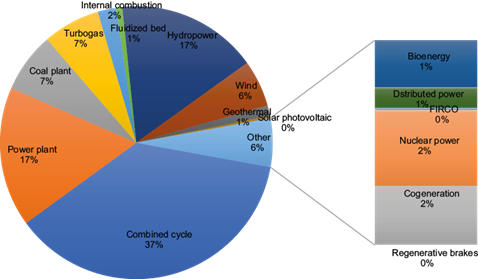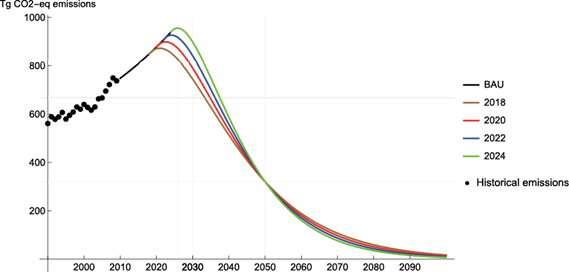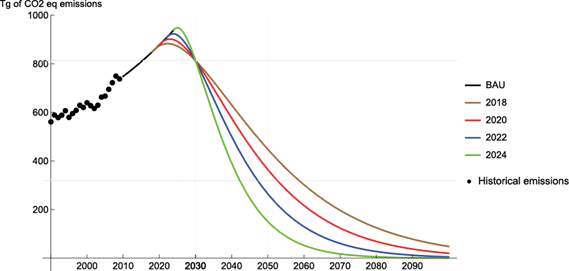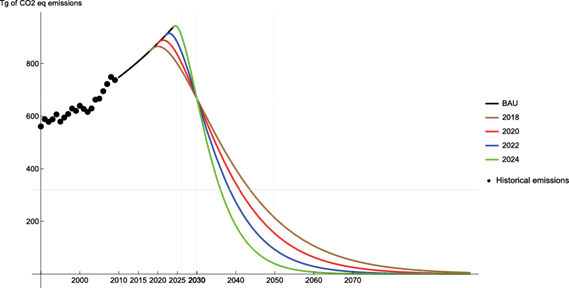1. Introduction
Article 4, paragraph 2 of the Paris Agreement (UN, 2015) states that “Each party shall prepare, communicate, and maintain successive nationally determined contributions (NDCs) that it intends to achieve”. Parties shall pursue domestic mitigation measures to achieve the objectives of such contributions. NDCs are to be submitted by the parties under two types of targets, unconditional and conditional in order to receive financial, technical, and capacity-building support.
The global emissions gap is the difference between where global greenhouse gases (GHGs) emissions are heading under the current Nationally Determined Contributions and where science indicates emissions should be in 2030 to be on a least-cost path towards limiting warming to below 2 ºC or further to 1.5 ºC (UNEP, 2021). The global emissions gap is 32 (29-35) Gt CO2-eq based on full implementation of unconditional NDCs and a 29 (26-31) Gt CO2-eq gap based on conditional reductions if 1.5º goal is sought. This finding unveils that, even if fully met, NDCs are insufficient to stabilize the global temperature below 2 ºC (Vandyck et al., 2016). NDCs are essential to accomplish the Paris Agreement because this bottom-up approach allows developing countries to include their circumstances and priorities, such as adaptation and finance (Pauw et al., 2018); hence the importance of complying with the NDCs as a first step on the way to stabilization of global temperature.
More than 25 years after signing the 1992 United Nations Framework Convention on Climate Change (UNFCCC), Mexico has excelled within developing countries with six submitted National Communications, two biennial reports, and their corresponding National Greenhouse Emission Inventories to the UNFCCC. Mexico’s active engagement in climate change issues is part of a foreign policy consisting of signing treaties, conventions, and agreements on environmental subjects (Cruz-Núñez and Straffon-Díaz, 2016). Such international participation has been reinforced domestically with the implementation of a robust body of laws, strategies, and programs (SEMARNAT 2012a, b, c, d, 2014), including the Ley General de Cambio Climático (General Law on Climate Change; SEMARNAT, 2012a), the Estrategia Nacional de Cambio Climático (National Strategy on Climate Change; SEMARNAT, 2013), and the National Determined Contribution (NDC) (México, 2015a) presented to the UNFCCC within the Paris Agreement and ratified in December 2020.
In its (México, 2015a; SEMARNAT, 2020), Mexico is committed to reducing its emissions of GHGs and short-lived climate pollutants (i.e., black carbon) unconditionally by 25% below its business as usual (BAU) projection for 2030. This commitment implies a reduction of 22% of GHGs and 51% of black carbon emissions. Mexico ratified the UNFCC’s 21st Conference of the Parties in September 2016 within the Paris Agreement, stating that, to achieve such commitments, it will reach a net emissions peak in 2026 and a corresponding decoupling of GHG emissions from economic growth. The emissions intensity per unit of gross domestic product (GDP) will need to be reduced by approximately 40% from 2013 to 2030 (SEMARNAT, 2012a).
The 22% reduction commitment could grow up to 40% subject to a global agreement that addresses important topics such as international carbon prices, carbon border adjustments, technical cooperation, and access to low-cost financial resources and technology transfer: all of these at a scale proportionate to the challenge of global climate change (Mexico, 2015a). Based on the same international agreement, GHGs reductions could increase to 36% and black carbon reductions could grow to 70% by 2030. Furthermore, Mexico has also set a target to generate 35% of its electricity via renewable technologies by 2024.
Mexico is a member of the G20 and the OECD, and it is the second-largest economy in Latin America. As part of North America, it is in close political, economic, and social relationship to the United States and Canada, sharing a tri-national trade agreement. Mexico shares 1.4% of the world GHGs emissions, and Pemex, the national oil company, is responsible for the emission of 20 025 Tg CO2-eq from 1854 to 2010, as the eighth of the most polluting companies worldwide (Heede, 2019). However, most petroleum derivatives are imported (Ferrari, 2013).
Currently, Mexico is the fourth country in America with more natural gas reserves and ranks fourth worldwide in geothermal energy, with an installed capacity of 1.07 GW in five fields (WEC, 2013). In recent years, solar uptake has increased to reach 234 MW in 2015 (IEA, 2020). In 2018 Mexico had a total installed capacity of 75 918 MW, of which clean technologies, representing 31.45% of the installed capacity, generated 23 875 MW. Of these, 20 620 MW are generated from renewable sources, in a mix shown in Figure 1.
In this study, the percentage emission reduction to achieve the mitigation objectives that Mexico proposed in its NDC is estimated. Besides, the possibility of Mexico’s compliance considering its importance as a climate leader in international climate policy and as a key emerging economy is analyzed.
2. Methods
Several emission mitigation pathways that fulfill the goals proposed by Mexico in its NDC and as national commitments, were estimated (Table I). Mexico’s emissions scenarios follow historical emissions trends, taken from the national database (INECC, 2015) until the year 2010, followed by a BAU scenario until year t m , when a mitigation effort begins. Values assigned to t m for different scenarios were: 2018, 2020, 2022, and 2024. The mitigation pathway after this point was followed using Eq. (1), which was set to achieve certain emissions reductions based on specific Mexican targets (Table I).
Table I Mexico’s Nationally Determined Contribution (NDC) and national commitments as stated in the Ley General de Cambio Climático (General Law on Climate Change, LGCC) and the Ley de Transición Energética (Energy Transition Law, LTE) (Mexico, 2015b).
| Pledge or contribution | Year to be achieved |
| Intermediate targets on renewables of 25% by 2018 and 30% by 2021 (LGCC) | 2018, 2021 |
| 30% reduction on emissions from the baseline (LGCC) | 2020 |
| 35% minimum share of clean energy in power generation (LTE) | 2024 |
| Emissions peak (LGCC, NDC) | 2026 |
| 22% reduction in GHG emissions to the BAU projection (unconditional) (LGCC, NDC) | 2030 |
| 36% reduction in GHG emissions to the BAU projection (conditional) (NDC) | 2030 |
| 50% reduction in GHG emissions with regard to historical emissions in 2000 (LGCC) | 2050 |
BAU: business as usual.
2.1 Emissions under the business-as-usual scenario
Mexico’s emissions under the BAU scenario were estimated by a linear extrapolation from the actual emission trend. A fifth-order polynomial was fitted to the estimated emissions under the current emissions scenario for Mexico from 2010 to 2100. This equation will subsequently be referred to as BAU.
2.2 Mitigation curve
Total emissions E(t) are assumed to follow the BAU pathway until a time t m . The mitigation efforts starting from year t m were estimated by an equation adapted from Sanderson et al. (2016):
which represents total emissions E(t) as a function of time and depends on five parameters: A, t e , E ∞ and τ to be solved, constrained to the following boundary conditions: E ∞ is the asymptotic emissions flux that the mitigation curve of Eq. (1) approaches; to simplify the equation, as well as the fact that this study addresses only the mitigation pathways in the near and medium horizons, the value of E ∞ was set to 0.
To solve parameters A and t e , Eq. (1) and its derivative were matched to the emissions computed by BAU and its derivative at year t m :
The pledged emissions in 2050 were assumed to be half the historical emissions in 2000 (Tg CO2-eq.):
τ represents how severe the mitigation measures are. A small τ close to 0 represents extreme mitigation measures that reach the emissions level E ∞ at a date close to t m , while a larger τ represents slower emissions reduction. Three values of τ were computed for each t m case, which correspond to the unconditional (22% reduction by 2030) and conditional (36% reduction by 2030) pledges and to an emissions peak in 2026. The 22 and 36% emissions reductions were computed using equation BAU (in Tg CO2-eq).
Unconditional case:
Conditional case:
Emissions peak at 2026 case:
Four sets of pathways were produced: mitigation pledge by 2050 constrained to Eq. (4), unconditional contribution by 2030 constrained to Eq. (5), conditional contribution by 2030 constrained to Eq. (6), and emissions peak in 2026 constrained to Eq. (7).
3. Results
Figure 2 shows Mexico’s historical emissions from 1990 to 2010. It also shows the extrapolated emissions after 2010 and, additionally, it shows the NDC to 2030 and the peak in 2026, as stated in the Ley General de Cambio Climático (SEMARNAT, 2012a) and the Programa Especial de Cambio Climático (Special Program on Climate Change) 2014-2018 (SEMARNAT, 2014).

Fig. 2 Historical data and trend according to the associated CO2-eq emissions of Mexico. Mexico’s mitigation pledges and its National Determined Contribution (NDC) are also shown (BAU: business as usual).
Four cases were simulated. In every case, a condition is imposed, according to Eqs. (4), (5), (6), and (7).
3.1 Case a
Figure 3 shows case a, in which only the 2050 pledge is simulated by several mitigation pathways. If mitigation starts in 2018, 2020, 2022, and 2024, emissions are reduced by an annual average rate of 3.39, 3.61, 4.00, and 4.44%, respectively, to reach the 2050 goal. Peak emissions are reached in different years in all cases.
3.2 Case b
Fulfillment of the 2030 unconditional contribution was simulated by solving Eq. (1) constrained to Eq. (5). Figure 4 illustrates such a scenario. Mean emissions are reduced annually by 1.02, 1.46, 2.09, and 3.01% if mitigation efforts begin in 2018, 2020, 2022, and 2024, respectively. The emissions peak is reached before 2026 in every pathway. It would not be possible to fulfill the NDC pledges if mitigation starts after 2024 unless a very stringent reduction of emissions is undertaken.
3.3 Case c
In this case the conditional 2030 contribution is followed according to Eq. (1) and constrained to Eq. (6). The results show that to reach the 2030 conditional contribution, mean annual reductions in emissions should be of 2.56, 3.11, 4.39, and 5.49% if mitigation begins in 2018, 2020, 2022, and 2024, respectively. Figure 5 illustrates such pathways. It is noteworthy that if this condition is fulfilled, the 2050 pledge will be reached in every case, and zero emissions will be reached before 2100.
3.4 Case d
Mitigation scenarios constrained to a peak in 2026 are presented in Figure 6. Colored lines for 2020, 2022, and 2024 correspond to the years in which mitigation would begin hypothetically to meet an emissions peak in 2026. If emissions mitigation is initiated later, reductions must be more stringent. Average annual reductions until 2030 for mitigation beginning in 2018, 2020, 2022, and 2024 are of 0.31, 0.42, 0.65, and 1.30%, respectively. However, if mitigation starts later, emission reductions shown as the slope of the mitigation pathway, should increase to achieve a peak in 2026. Consequently, the targeted emissions reduction by 2050 would be reached some years in advance.
4. Discussion and conclusions
Key sources of GHG emissions include energy generation (21.7%) and transport (20.5%) (INECC, 2015) (Fig. 7). The residential and commercial sectors rely on the consumption of liquefied petroleum gas (Rosas-Flores, 2017) and biomass and coal in the rural sector (SENER, 2018).

Fig. 7 Emissions by source category in Mexico (with data from the National Emissions Inventory [INECC, 2020]).
Changes by decade show, in general, a decrease in the 2010-2017 period with respect to 1990-2000 and 2000-2010 by sector, while total emissions grow in the last seven-year period, as shown in Table II.
Table II Changes in the emissions inventory by period and category*.
| Emission category | Change (%) | |||
| 1990 -2000 | 2000-2010 | 2010-2017 | 2018-2019 | |
| 1. Energy | 2.94 | 2.46 | 1.01 | -5.95 |
| 2. Industrial processes and product use | 1.82 | 3.06 | 2.17 | -1.47 |
| 3. Agriculture, forestry and other land uses | 0.80 | -0.72 | -44.6 | 10.42 |
| 4. Waste | 8.74 | 6.99 | 2.4 | 2.43 |
| CO2 emissions from biomass burning | -1.74 | -0.78 | -14.28 | 21.32 |
| Total emissions | 2.87 | 2.93 | 4.62 | -6.17 |
*With data from the National Emissions Inventory (INECC, 2020).
The energy sector has a relevant contribution to the National Emission Inventory. Its share was 87.5% in 2019 (INECC, 2022). In Table III, the CO2 intensity per energy mix (CO2/TPES) is shown. The higher values reveal increased CO2 emissions per unit of energy produced.
Table III CO2 intensity per energy mix*.
| Year | CO2/TPES (tCO2/toe) |
| 1990 | 2.08 |
| 1995 | 2.21 |
| 2000 | 2.39 |
| 2005 | 2.28 |
| 2010 | 2.47 |
| 2015 | 2.39 |
| 2018 | 2.41 |
| 2020 | 2.17 |
*Own calculations with data from IEA Data Services (https://www.iea.org/subscribe-to-data-services/world-energy-balances-and-statistics).
toe: tons of oil equivalent.
The CO2 intensity numbers per energy mix show a general continuous increase except for 2015 and 2020 (being the latter a pandemic year, when economic activities were substantially reduced). A continued economic contraction fueled by the pandemics has led to a reduction in national emissions (CAT, 2021).
Mexico’s last 12 years of governance and the current administration mitigation strategy are not on track for the compliance of Mexico’s NDC by 2030 (CAT, 2021). In its NDC, Mexico established emission reductions by emission categories, reforestation, transportation, and, most importantly, the renovation of the industrial plant. The main driver in decarbonization should lay a new energy system with a high share of renewable energies in the national primary energy mix, the switch-on industry, and mitigation in the transportation sector, mainly the passenger and cargo fleet (García-Reynoso et al., 2013).
Mexico’s progress in in the fulfillment of this commitments is currently insufficient to achieve the decarbonization and mitigation goals established in its NDC. The performance of the main Latin American economies is similar to Mexico’s economy, with commitments that are modified every change of regime, e.g., in Brazil. Den Elzen et al. (2013) concluded that it is highly unlikely that Mexico and Brazil will be able to comply with their commitments based on the available information. In North America, only Canada has reduced its emissions by 3.1% with an economic growth of 12.9% from 2005 to 2013 (Canada, 2015), albeit its emission reduction requires further action to achieve their targets (den Elzen et al., 2019). As in many developing countries, Mexico’s GHGs emissions per capita are much lower than the International Energy Agency’s average (IEA, 2017). If Mexico implements its NDC pledge effectively, per capita GHG emissions will still be one of the lowest among the G20: higher than India, but two-thirds of China’s emissions, half of the European Union’s, and only 30% of the per-capita GHG emissions of the USA (IEA, 2017).
This simple model only allows estimating the emission reductions required to reaching the mitigation goals that Mexico has committed to pursue in different international forums. According to this work, emissions must be reduced between 2 and 6% annually to fulfill the commitments made by Mexico, depending on the year mitigation starts. The reduction of Mexico’s emissions should have been effectively implemented in early 2018 to achieve the goals established in its NDC at reasonable emission reduction rates. Mitigation should be started no later than 2020 to achieve a peak emission in 2022 and both the unconditional 2030 and the 2050 mitigation goals. A later startup requires a significant mitigation effort to achieve the 2030 targets. Achieving an emissions peak in 2026 is unlikely to be sufficient to fulfill Mexico’s NDC pledges by 2030. Emissions peak should be reached no later than 2022 if mitigation began in 2020. The reduction in emissions due to the recent coronavirus pandemic provided an opportunity for countries to redirect climate policy on a new emissions basis.
Postponing emissions mitigation may be more expensive over time. While developing countries deal with development and achieving equity and sustainability, they must also achieve growth under low emissions. The pillars of Durban, mitigation, adaptation, technology development and transfer, transparency in action and support, and capacity-building must permeate the NDC to achieve the overall objective. If Mexico does not achieve its NDC, the international implications, both political and climatic, could put the NDC model at risk if there are more large emitters that do not comply with their mitigation pledges.











 nueva página del texto (beta)
nueva página del texto (beta)







